Start Licensing’s Ian Downes finds some examples of how licensing can make a positive contribution to retail theatre this week.
People often talk about retail theatre and how brands can make an impact at retail. Licensing is an added value business and in the context of the retail market can make a positive contribution to retail theatre.
This observation was reinforced for me this week by a visit to NikeTown at Oxford Circus. This Nike store is very much a destination store and is on a lot of shoppers ‘must visit’ list when in London. It is always well presented and has a very positive vibe. It is located on a busy corner and makes a positive contribution to the local shopping area – Oxford Street has suffered recently with a decline in the quality of retail outlets on the street, so it is good to see a top tier brand like Nike supporting the area in such a proactive way.
That said at the moment NikeTown is ‘under repair’ – one side of the building is covered in scaffolding which must be frustrating for the retailer as it reduces the window displays and the overall aesthetic of the store. It also must be frustrating not least as the work is underway during the summer trading period and specifically in the run up to the Women’s World Cup – a significant selling opportunity for Nike.
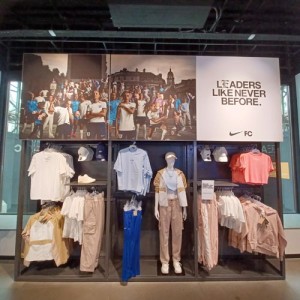 However on the ground floor of the store, Nike has more than overcome this challenge with a fabulous display and installation focused on the Women’s World Cup. The primary focus is on the England team and there is a full range of products on sale including replica kits, training kits, loungewear and accessories. The collection is presented stylishly and in a high impact way. I think there is a consumer focused in-store activation as well – a nice way of further involving consumers with the brands.
However on the ground floor of the store, Nike has more than overcome this challenge with a fabulous display and installation focused on the Women’s World Cup. The primary focus is on the England team and there is a full range of products on sale including replica kits, training kits, loungewear and accessories. The collection is presented stylishly and in a high impact way. I think there is a consumer focused in-store activation as well – a nice way of further involving consumers with the brands.
The in-store campaign and messaging lives under a focused message of ‘Leaders Like Never Before’. In addition to the England range there are replica kits from other countries that Nike supplies including France. This reflects the fact that NikeTown is a tourist destination but, of course, that London is a cosmopolitan city with fans from different countries living in the city. Stocking other teams’ kits also helps underpin the global reach of the tournament and Nike’s global capabilities. This was a really good example of a retailer using licensing, a popular event and its brand equity to make a real impact at retail.
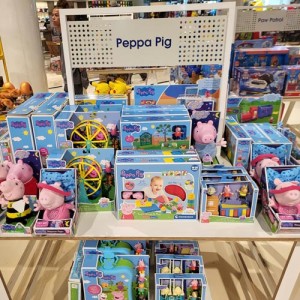 Sticking with retail and how licensing is being used in retail at the moment, I got some help with my Looking Out again this week.
Sticking with retail and how licensing is being used in retail at the moment, I got some help with my Looking Out again this week.
Ben Townsend from Aardman visited Birmingham and took the opportunity to do some Looking Out. He visited Selfridges and Ben was able to report that licensing is playing a big part in key areas of the store such as toys and gifts.
Selfridges has chosen to feature brands it supports in a coordinated way and across categories in curated areas.
Featured brands include Paddington, Peppa Pig, PAW Patrol and Pokémon – and that was just the Ps!
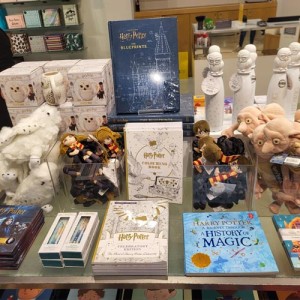 Other brands featured included Bluey which seems to be performing well at retail. Beyond the children’s area, Selfridges was supporting the heritage sector with a strong display for V&A and it was also supporting Harry Potter.
Other brands featured included Bluey which seems to be performing well at retail. Beyond the children’s area, Selfridges was supporting the heritage sector with a strong display for V&A and it was also supporting Harry Potter.
According to Ben, the store was well presented and made great use of displays to sell product. This is certainly a strength of licensed brands. Well chosen licences can really help stores and it seems Selfridges has made a conscious decision to develop a licensing lead strand to its retail ‘content’. This approach creates a destination store effect with consumers knowing they will find brands they are interested in under one roof.
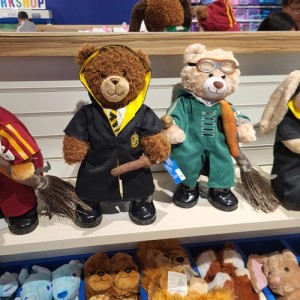 Interestingly Selfridges has extended this sense of being a destination store by including a Build-a-Bear concession which in turn relies heavily on licensed brands such as Harry Potter. I can see more retailers working collaboratively with brands such as Build-a-Bear to help enhance their retail offering and experience.
Interestingly Selfridges has extended this sense of being a destination store by including a Build-a-Bear concession which in turn relies heavily on licensed brands such as Harry Potter. I can see more retailers working collaboratively with brands such as Build-a-Bear to help enhance their retail offering and experience.
Department stores, of course, have a lot of floor space to fill and adding in the likes of Build-a-Bear helps utilise some of this space effectively, while adding new reasons for consumers to visit and dwell in-store. I remember working on shop-in-shop concepts in the 1990s when at Fox Kids in markets like Holland and it worked very well. It is certainly a model that has some merits and plays well to licensing strengths.
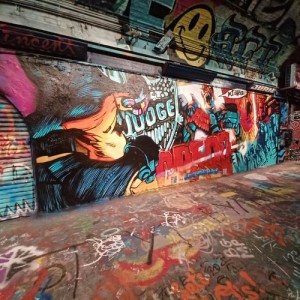 It was also good to get a visit into Waterloo’s Leake Street this week. This is a hub for street art. Quite often street artists are inspired by well known characters and brands.
It was also good to get a visit into Waterloo’s Leake Street this week. This is a hub for street art. Quite often street artists are inspired by well known characters and brands.
Recently a number of street artists have created artwork at Leake Street as part of the ‘Do One Cancer’ street art jam. I think this is an annual event where street artists get together there to create artwork to raise awareness of health, well being and fundraising associated with cancer. One of the artworks painted for the campaign this time was one featuring comic character Judge Dredd. It was a large scale piece and was a great representation of Dredd. It is always interesting to see what brands influence street artists and their approach to artwork. Street art is seemingly becoming more influential in regards to contemporary design and fan culture.
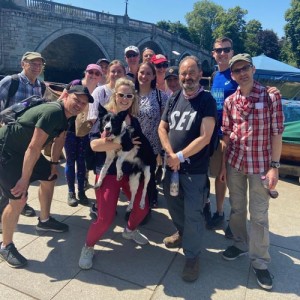 Finally it was another week another walk for me. I joined Rainbow Productions and a number of other licensing friends to walk 50K on Friday (7 July) – we crossed the London Bridges from Hampton Court to Tower Bridge. The walk was a fundraiser for The Light Fund and Mind. Once again the walk and talk format was a great way of catching up with people and discussing some new opportunities.
Finally it was another week another walk for me. I joined Rainbow Productions and a number of other licensing friends to walk 50K on Friday (7 July) – we crossed the London Bridges from Hampton Court to Tower Bridge. The walk was a fundraiser for The Light Fund and Mind. Once again the walk and talk format was a great way of catching up with people and discussing some new opportunities.
Now we are in the summer months and the License To Move initiative is live it might be a good moment to set up some ‘Walk and Talk’ meetings – you could double these up as ‘retail visits’ as well. Remember to Lookout on your walk!
Ian Downes runs Start Licensing, an independent brand licensing agency. His Twitter handle is @startlicensing – he would welcome your suggestions for what to look out for.































